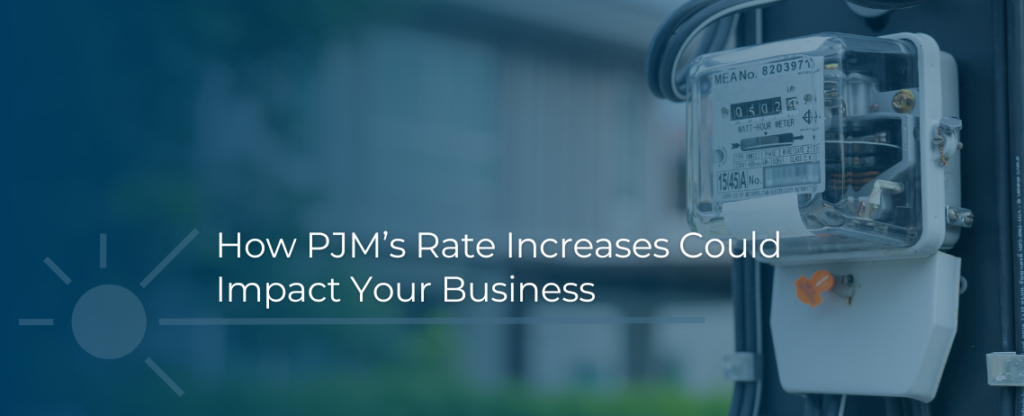
Businesses that operate in the PJM Interconnection region could see energy costs climbing soon—and for some, it may be significant.
PJM Interconnection, the organization responsible for managing electricity across 13 states in the Mid-Atlantic and Midwest regions and Washington D.C., has announced a major increase in capacity prices for the 2025-2026 delivery year and beyond.
Starting in June 2025, some commercial customers could see a rate hike of up to 29% on their capacity price, which determines the cost of electricity reliability.
While businesses across various industries could see negative bottom-line impact with the upcoming PJM rate increase, it also presents an opportunity to rethink energy strategies. Instead of simply reacting to the rising costs and paying a higher energy bill, there are ways for business owners to take back control.
What’s Causing the PJM Rate Increase?
PJM is a grid operator that ensures the reliability of power. To maintain that reliability, grid operators plan years ahead to make sure there is enough electricity to supply future demand. One method of planning used is an annual capacity auction, which helps secure the commitments from energy resources like power plants to be available when needed, especially during peak demand periods or emergencies.
Following the most recent capacity auction, PJM’s price for the 2025-2026 delivery year is expected to rise from $50 to $269.97 per megawatt-day.
The drastic increase is driven by a few key factors:
- Issues with gas power plants operating in extreme weather
- An interconnection backlog
- Higher demand from growing industries
- Overall grid reliability issues
As a result, PJM must pass those higher costs along to both residential and commercial energy users, leading to a steep increase in electricity rates. And with grid reliability still a concern, the trend of rising capacity costs could continue in future auctions.
What Businesses Will Be Impacted by PJM Rate Increases?
Any business in PJM’s territory that relies heavily on energy will feel the impact as operating costs rise, especially those with already tight budgets. However, there are some that may feel the impact more than others.

Hospitals and Healthcare Systems
Healthcare systems are always under pressure to keep costs down while providing the best patient care possible. Hospitals and healthcare facilities operate 24/7, meaning energy is a constant and a major operating expense. As these price increases roll out, healthcare systems will need to find ways to manage rising electricity costs while maintaining patient care standards.
Rising energy bills could also limit funding for other areas, making energy efficiency a top priority to help keep costs in check.

Industrial Companies
For industrial companies that rely heavily on energy-intensive machinery, rising electricity costs are a major concern. Manufacturing processes often run around the clock, and the cost of energy can make or break profitability.
Increased costs could affect the price of goods manufactured, and companies may need to explore ways to reduce energy consumption or alternative energy sources to keep production running smoothly and cost effectively.
Auto Dealerships

Showrooms, service centers, and parking lots at auto dealerships all require energy, and with prices increasing, so will overhead costs. That means higher bills for lighting, HVAC, and service operations. And for dealerships looking to expand their electric vehicle (EV) offerings, there’s an added complexity of powering charging infrastructure, potentially making energy bills even more unpredictable.
Commercial Real Estate (CRE) Portfolios

CRE owners, especially those with multi-tenant properties, will also face pressure as electricity prices rise. Increased operating costs could reduce net operating income (NOI), particularly for owners and operators of office buildings, retail spaces, and multifamily communities. Additionally, properties with high energy-consuming operations may face rising utility costs that could impact both the tenants and owner.
Owners may need to pass increased energy costs to tenants or find a way to offset rising expenses through energy-efficient property upgrades.
How Can Businesses Combat PJM’s Rising Costs?
There are ways for businesses to avoid PJM’s rate hike, with one option being distributed generation (DG) solutions. A DG system typically includes a power generation source (i.e. solar) and energy storage (i.e. battery storage), which enables businesses to generate their own power on-site.
DG systems help to stabilize energy costs and avoid volatile utility rates. Additional benefits include:
- Reduced energy costs due to less power being purchased from the grid
- Less reliance on the grid during peak demand hours when power is most expensive
- More control over your energy supply
- Ability to maintain operations during outages or peak demand periods
- New revenue streams by selling energy back to the grid
- Reduced carbon emissions to meet sustainability and ESG goals
Your Partner for Every Step of the Distributed Generation Process
SitelogIQ is your one-stop partner for all project phases of distributed generation solutions. In addition to being your consultant and contractor, we’re also a strategic partner that manages all phases of a project from planning and utility coordination, to installation and incentive management. Our team also helps you identify funding strategies and navigates incentive applications and management on your behalf—we ensure you never leave money on the table.
As operating expenses continue to rise for businesses, we’re here to help make yours more energy efficient and help you combat increasing costs. Let’s chat about your specific needs today.







